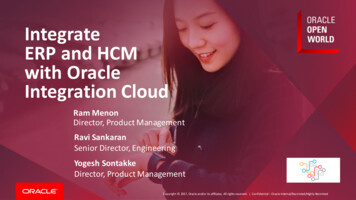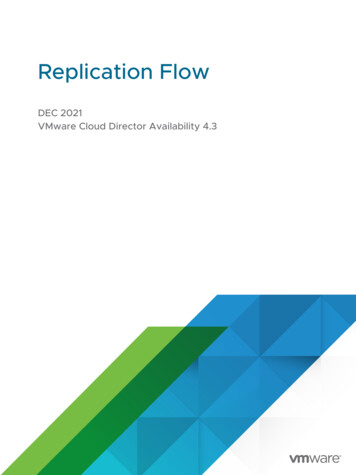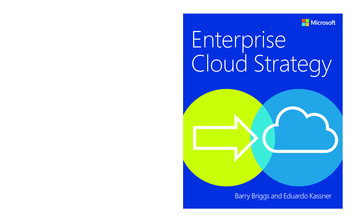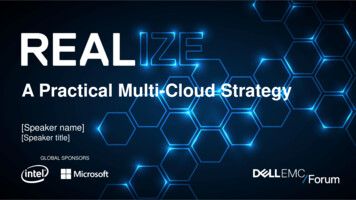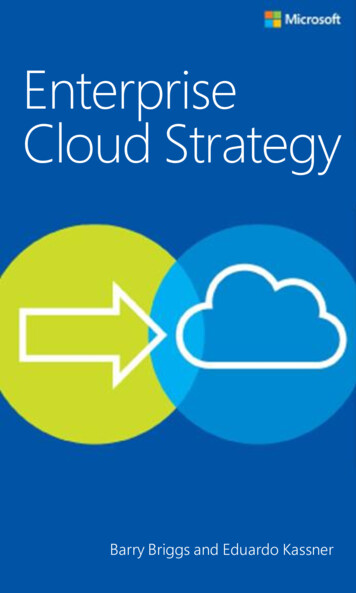
Transcription
EnterpriseCloud StrategyBarry Briggs and Eduardo Kassner
PUBLISHED BYMicrosoft PressA division of Microsoft CorporationOne Microsoft WayRedmond, Washington 98052-6399Copyright 2016 by Microsoft CorporationAll rights reserved. No part of the contents of thisbook may be reproduced or transmittedin any form or by any means without the writtenpermission of the publisher.Library of Congress Control Number:ISBN: 978-1-5093-0196-6Printed and bound in the United States of America.First PrintingMicrosoft Press books are available throughbooksellers and distributors worldwide. If you needsupport related to this book, email Microsoft PressSupport at mspinput@microsoft.com. Please tell uswhat you think of this book athttp://aka.ms/tellpress.
This book is provided “as-is” and expresses theauthor’s views and opinions. The views, opinionsand information expressed in this book, includingURL and other Internet website references, maychange without notice.Some examples depicted herein are provided forillustration only and are fictitious. No realassociation or connection is intended or should beinferred.Microsoft and the trademarks listed lectualProperty/Trademarks/EN-US.aspx aretrademarks of the Microsoft group of companies.All other marks are property of their respectiveowners.Acquisitions Editor: Karen SzallDevelopmental Editor: Karen SzallEditorial Production: Dianne Russell, OctalPublishing, Inc.Copyeditor: Bob Russell, Octal Publishing, Inc.Cover: Twist Creative Seattleii
Hearaboutit first.Get the latest news from Microsoft Press sentto your inbox. New and upcoming booksSpecial offersFree eBooksHow-to articlesSign up today atMicrosoftPressStore.com/Newsletters
Visit us today atMicrosoftPressStore.com Hundreds of titles are available –Books, eBooks and online resourcesfrom industry experts Free U.S. shipping eBooks in multiple formats – Read on yourcomputer, tablet, mobile device or e-reader Print & eBook Best Value Packs eBook Deal of the Week – Save upto 60% on featured titles Newsletter and special offers – Bethe first to hear about newreleases, specials and more Register your book – Getadditional benefits
Free ebooksFrom technical overviews to drilldowns onspecial topics, get free ebooks fromMicrosoft Press at:www.microsoftvirtualacademy.com/ebooksDownload your free ebooks in three formats: PDFEPUBMobi for KindleLook for other great resources at MicrosoftVirtual Academy, where you can learn newskills and help advance your career with freeMicrosoft training delivered by experts.Microsoft Press
ContentsIntroduction . viAcknowledgments .viErrata, updates & book support . viiFree ebooks from Microsoft Press . viiiWe want to hear from you .ixStay in touch .ixChapter 1: The cloud, efficiency and innovation1Economics of the cloud . 2Daily efficiencies . 7Innovation . 7Telenor . 9Aviva . 123M Parking Systems . 15Heineken . 17Lessons Learnt . 20Chapter 2: Journey to the cloud: the roadmap 23i
Don’t miss the opportunity to modernise . 27Evolution of the five Rs of modernisation . 30Cloud migration: three stages. 34Chapter 3: Experimentation . 37Microsoft IT’s first cloud application . 37Experimentation and the problem of “shadow”IT . 40Chapter 4: Migrating IT to the cloud . 47Establish strategy and goals . 49Organisational responsibilities in creatingthe strategy. 57Enterprise architecture . 57Information security and risk management . 61Data classification . 64Enterprise Risk Management . 66Finance . 66Operations. 70Human resources and the evolution of roles . 74Applications teams . 77Business units . 80Building the catalogue . 81ii
Top-down portfolio analysis . 83Bottom-up portfolio analysis . 87The cloud migration plan . 91Microsoft IT’s experience . 96Cloud governance . 99Data governance. 100Financial governance . 102Security and Compliance . 103Change management . 104Information Technology Infrastructure Libraryand the cloud . 106Chapter 5: Transformation . 111Platform as a Service architecture . 112Containers and micro-services. 114Storage . 116Relational databases in the cloud . 117NoSQL (non-relational) storage . 120Analysis . 128Integration . 133Using services to create rich end-to-endapplications . 135iii
Conclusions . 140Appendix A: Cloud architectural blueprints . 142Data analytics. 142BI and analytics . 146Live media streaming . 149Video on demand (VOD) . 152Line-of-business applications in infrastructureservices . 156Hybrid cloud storage . 159E-commerce website . 161Business-to-business (B2B) e-commerce . 164Multichannel marketing . 166DevOps . 169Appendix B: Sample technology scenarios . 174Hybrid cloud scenarios . 174Hybrid cloud connectivity . 175Using the cloud for data backup andrecovery . 179Hybrid database scenarios . 186Development and test . 188Application development . 189iv
Microsoft SharePoint . 190High availability in the cloud . 191Connected devices . 195Identity and authentication . 198Mobile applications . 201Enterprise mobility management . 203Websites . 206Azure Media Services . 209Migration strategies . 212Appendix C: Recommended references . 215Storage references . 215Application development and insightsreferences . 216Performance best practices references . 216Other cloud migration references . 218About the authors . 219v
IntroductionWhen briefing CIOs and senior IT executives atMicrosoft, we are often told that migrating ITworkloads to the cloud ranks among their highestpriorities. That statement is almost inevitablyfollowed by “How do I start?”; “How should I builda plan for cloud migration for my entire portfolio?”;and “How will my organisation be affected by thischange?”This book, based on real-world cloud experiencesby enterprise IT teams, seeks to provide answersto these questions. Here, you’ll see what makes thecloud so compelling to enterprises; whichapplications you should start your cloud journeywith; how your organisation will change, and howskill sets will evolve; how to measure progress; howto think about security, compliance and businessbuy-in; and how to exploit the ever-growingfeature set that the cloud offers to gain strategicand competitive advantage.AcknowledgmentsThe authors wish to express their deep gratitude tothe following individuals for their support,viIntroduction
guidance and their willingness to freely share theirexpertise: Scott Woodgate, Javier Nino,Tom Schinder, Venkat Gattamneni, Martin Vliem,Ulrich Homann, Robert Hanegraaff, John Devadoss,Brenda Carter, Michael Washam, Zoiner Tejeda,Nadia Matthews, Rob Beddard, Jeff Fryling, KevinGee, Colin Nurse, Raman Johar, Walter Myers, UweHoffman, Ashish Sharma, Ashutosh Maheshware,Rich Nickerson, Michel Declercq, Arlindo Alves,Dennis Mulder and George Moore.Rob Boucher and Monica Rush created thegraphical representations of the blueprintsin the Appendices.Errata, updates & booksupportWe’ve made every effort to ensure the accuracy ofthis book and its companion content.You can access updates to this book—in the formof a list of submitted errata and their iIntroduction
If you discover an error that is not already listed,please submit it to us at the same page.If you need additional support, email MicrosoftPress Book Support at mspinput@microsoft.com.Please note that product support for Microsoftsoftware and hardware is not offered through theprevious addresses. For help with Microsoftsoftware or hardware, go tohttp://support.microsoft.com.Free ebooks fromMicrosoft PressFrom technical overviews to in-depth informationon special topics, the free ebooks from MicrosoftPress cover a wide range of topics. These ebooksare available in PDF, EPUB and Mobi for Kindleformats, ready for you to download at:http://aka.ms/mspressfreeCheck back often to see what is new!viiiIntroduction
We want to hear from youAt Microsoft Press, your satisfaction is our toppriority, and your feedback our most valuableasset. Please tell us what you think of this book at:http://aka.ms/tellpressWe know you’re busy, so we’ve kept it short withjust a few questions. Your answers go directlyto the editors at Microsoft Press. (No personalinformation will be requested.) Thanks in advancefor your input!Stay in touchLet’s keep the conversation going! We’re onTwitter: http://twitter.com/MicrosoftPressixIntroduction
CHAPTER1The cloud, efficiencyand innovationMost people now agree that thecloud has become a core elementof any enterprise’s technologystrategy. Indeed, in the past few yearswe have seen the conversationaround cloud adoption move from“if” to “when” and “how.” It is, inshort, a fact of life.Nevertheless, it remains one of the most disruptivechanges in computing in years, and it is worthreviewing what makes the cloud so compelling toenterprise IT. Its value proposition is many-faceted,ranging from significant cost savings over atraditional datacentre approach to the ability toquickly build robust, resilient applications that can1C H A P T E R 1 The cloud, efficiency, and innovation
scale up as traffic spikes and scale down as itrecedes.Economics of the cloudIn cloud computing, enterprises pay for what theyuse, much as they would a telecom provider.If demand decreases and you no longer needcapacity, you can turn off systems and you are notcharged. This simple model stands in stark contrastto the traditional model of enterprise computing,which is a capital-intensive function, requiringexpensive datacentres, electricity, air conditioning,servers, networks, storage and 24 7 operationsstaff. For most companies, maintaining a large ITpresence in this model implies large capitalexpenditures and a non-trivial amount ofaccounting and record-keeping to trackdepreciation, tax considerations and so forth.Moreover, when you purchase the hardware andthe software, they become yours in every sense ofthe word. Operations staffs are responsible forhardware swaps, networks, backups, updates foroperating systems and upgrades to the systemsoftware and applications. The traditional model isa “capital expense” model.The cloud, being subscription-based, is anoperating expense model. In the cloud, computing2C H A P T E R 1 The cloud, efficiency, and innovation
becomes a service for which customers are billed amonthly charge. Like other such services, it ismetered by usage. The more computing, networkand storage resources you use, the higher your bill.Of course, the reverse is also true: the less you use,the less you are charged. Indeed, most ITorganisations find wide variations in systemutilisation: some applications (for example, retailshopping) are seasonal; other applications (forexample, training applications) run for a shortperiod of time before being shut down; others aresimply unpredictable. The cloud addresses thisvariability (shown in Figure 1-1) perfectly via its“pay for what you use” model.3C H A P T E R 1 The cloud, efficiency, and innovation
Figure 1-1: Common application utilisation models(It is worth mentioning that in the on-premisesdatacentre, the maximum utilisation must beplanned for and provisioned, which is financially farmore inefficient than in the cloud.)But, there is more to it. Operating in the cloud freesenterprises of the mundane tasks of systembackup, network maintenance, patches andsoftware upgrades, because the cloud provider canhandle these in their entirety. The cloud provider in4C H A P T E R 1 The cloud, efficiency, and innovation
turn is heavily incentivised to utilise, and in manycases, pioneer best practices for systemmaintenance; the benefits are then passed to thecustomer.Moreover, cloud providers such as Microsoft canachieve economies of scale by buying hardwarein massive bulk, tens of thousands of servers at atime, for example. Very large datacentres hostingpublic clouds can also achieve economies inpurchasing other resources; cloud datacentres payonly a quarter of the average cost of electricity inthe United States. Figure 1-2 shows how overalltotal cost of ownership (TCO) per server declinesdramatically at scale.Figure 1-2: Economies of scale in the cloud5C H A P T E R 1 The cloud, efficiency, and innovation
These savings can be, and are, passed on tocustomers of the cloud service.1 Indeed, althoughan IT department can certainly create a private(internal) cloud of a thousand or so servers, usingthe public cloud can result in savings up to tentimes!2Later, we will discuss how IT departments canquantify the savings they can expect to achieveby adopting cloud computing.Perhaps most importantly, the cloud is not an“either/or” proposition. It is certainly possible, andindeed in many cases desirable, to leave someapplications running in a local, traditionaldatacentre while others are migrated to the cloud.Providers such as Microsoft have made hugeinvestments in this hybrid cloud model thatsecurely connects applications in the cloud tothose remaining in a customer’s datacentre.See “Economics of the Cloud” skits/cloud/docs/TheEconomics-of-the-Cloud.pdf2 John Rex, CFO Microsoft North America, analystpresentation16C H A P T E R 1 The cloud, efficiency, and innovation
Daily efficienciesAfter there is an on-demand computing serviceavailable, all sorts of other efficiencies becomepossible. For example, systems devoted todevelopment and application testing oftenconstitute a large cost area for IT departments, yetin the end do not actually provide any direct valueto end users. With the cloud, developers andtesters can quickly allocate cloud-based resources,use them for their work, and then free them upwhen they've finished. Similarly, with the vast,capacious amounts of cheap storage available inthe cloud, data backup to the cloud, and acrossmultiple geographies if desired, becomes astraightforward and inexpensive function. We willcover more of these in the course of the book.InnovationOf course, at the end of the day, the goal of anymodern enterprise strategy is to create competitivedifferentiation and advantage, and little doubtremains that IT has become a key element in thisstrategy. IT now drives transformative innovation,enabling enterprises to compete more effectivelyby instantiating processes that deliver ongoingcompetitive advantage.7C H A P T E R 1 The cloud, efficiency, and innovation
As we will see, the emergence of a globalcomputing cloud heralds the arrival of entirely newclasses of innovation across applications andmarkets. Indeed, such new forms of innovation canactually transform an organisation and a business.Transformational innovation drives a differentculture and mind-set than most organisationscurrently have. Affecting both IT and the leadershipof the enterprise as a whole, this culture requires aclose alignment between IT and businessleadership.In the next few pages, we will examine a number ofcase studies from various global companies,all of which have reaped rewards by their use of thecloud. The first, Telenor, shows how even asimple migration of on-premises applications canmake it possible for it to be far more cost-effectivein its operations. The second, Aviva, demonstrateshow an insurance company used mobile phonesand the cloud to create an innovative approach todynamic insurance pricing. In a third case study,3M Parking Systems opted for a cloud-basedsolution when it needed a way to track itsthousands of devices in the field. Lastly, thebeverage giant Heineken chose the cloud as a wayto deliver a global media campaign tied in with therelease of a major motion picture, and thefollowing year, with major sporting events.8C H A P T E R 1 The cloud, efficiency, and innovation
TelenorThe Telenor Group is a Norwegiantelecommunications company with worldwideoperations serving almost 150 million mobilesubscribers. To modernise its intranet andcollaboration sites and deliver better search withinand across business units, Telenor will soonmigrate from the Microsoft SharePoint 2007 webapplication platform to SharePoint 2013. With 13different business units spread across 12 countries,Telenor’s prime business objectives were toimprove collaboration and best-practice sharing,bolster process efficiency and facilitate a moreagile and responsive organisation. Through theenhanced capabilities of SharePoint 2013, Telenorcould also reduce significantly the complexity andmaintenance cost of the 150-plus custom featuresinstalled on its IT network. That network, withapproximately 40,000 users, utilises two SharePointfarms to support more than 20,000 site collections,70 web applications and 100 content databases.Telenor’s IT structure is highly distributed across itsbusiness units, with ownership of corporate-wideinitiatives held by a central team at the TelenorGroup level. The various business units areempowered to make the best decisions for theirparticular business. Although this structure fostersinitiative, speed and agility, it also results in9C H A P T E R 1 The cloud, efficiency, and innovation
decreased company-wide integration betweenbusiness units (the classic IT trade-off betweenindividualised flexibility and central control).Telenor sought to balance and mitigate this tradeoff by modernising its shared infrastructure andprocesses so that its business units could stillfunction independently, but stay within anefficiently managed, cohesive, company-wideinfrastructure.To accomplish this goal, a Telenor project teamestimated that more than 80 servers, plusadditional servers for load and scale testing of thearchitecture, would need to be brought online aspart of developing, testing and running demos ofSharePoint 2013. The time and cost of getting thishuge infrastructure up, tested and operational wasestimated to exceed any reasonable timeframe andbudget using Telenor’s standard IT approach.Furthermore, a SharePoint project of this sizerequired a significant amount of serverinfrastructure across all environments, as well asinclusion of Microsoft Active Directory andExchange.The project team quickly realised that it needed totake a different approach.Microsoft Azure Virtual Machines, which are builton Azure’s Infrastructure as a Service (IaaS), made it10C H A P T E R 1 The cloud, efficiency, and innovation
possible to quickly create the development andtesting environment essential to Telenor’ssuccessful deployment of SharePoint 2013. Theexpected three-month window to set up theenvironment for a system of this size was reducedto two weeks, a huge saving not only in terms oftime, but also in costs.SharePoint 2013 is a sophisticated product thatintegrates with other Microsoft products such asWindows/IIS, SQL Server and Active Directory. WithSharePoint 2013, both a scale-up and a scale-outstrategy can be adopted, meaning that thedifferent parts of SharePoint can have multipleinstances across different servers, either virtual orphysical. For example, if a network needs moresearch servers, it’s simply a matter of adding moreservers running these components. For Telenor,development and testing of SharePoint 2013 inVirtual Machines meant that IT could scaleresources up or down, quickly and easily, with noup-front capital expense.“Because of Microsoft Azure Virtual Machines,Telenor saved 70% on test, development and demotime that could be turned off when finished tominimise its capital outlays,” says Marius Pedersen,associate systems architect, Microsoft, Norway.“They loved how quickly they were able toimplement, and the scalability of the solutions, all11C H A P T E R 1 The cloud, efficiency, and innovation
without the need for a huge capital investment.There was simply nothing else that could solvetheir overall big picture for this deployment likeVirtual Machines.”“Testing a big new deployment like this is essentialto success, but development and testing cantake up a lot of time and it normally requires thatwe buy many extra servers that, once testing isconcluded, we don’t really need anymore. And thatcosts us considerable money and other resources,”declared Andreas Høgberg, director, Telenor.AvivaA leading provider of insurance, savings andinvestment products, London-based Aviva serves43 million customers worldwide. The companywanted to design an innovative pricing model thatwould reduce premiums for the appropriatecustomers, but first it needed a betterunderstanding of driving habits. Traditionally, carinsurance premiums were determined not just bythe driver’s history, but also by statisticalprobabilities, including age and gender.Aviva sought a better approach. “We wanted togive people an individual price,” says JasonVettraino, application architect at Aviva. “We didn’t12C H A P T E R 1 The cloud, efficiency, and innovation
want to say ‘You’re in your forties, so you mustdrive like my dad.’”Until very recently, this kind of approach wouldhave required purchasing and installing individualblack boxes in vehicles to collect the data andtransmit it back to the company’s datacentre, whichwould need to be scaled-out to handle theincreased storage and computing capacity neededto process all the data. The expense of thisapproach would have been prohibitive.Advances in consumer mobile devices and cloudcomputing opened up new opportunities, andAviva realised it had alternatives to building out itsdatacentre and installing black boxes in itscustomers’ vehicles. “Suddenly in 2012, all of theconstraints we faced before had eased,” saysVettraino.Aviva looked for a hybrid cloud–based solution thatwould take advantage of its customers’ own mobilephones. The company needed a flexible, highlyscalable infrastructure that would integrate with itsexisting on-premises quote system as well asexternal web-based services and secureapplications running on those mobile phones.Aviva began refining its rating algorithm andstrategy for integrating social networks such as13C H A P T E R 1 The cloud, efficiency, and innovation
Facebook and Twitter. Next, the company workedwith Microsoft Visual Studio 2010 and theMicrosoft .NET Framework 4 to build its Aviva Driveapp for mobile phones. The development platformincluded Azure SQL Database and the Azure Tablestorage service. Developers also used tools in theAzure SDK—including Azure Compute Emulatorand Azure Storage Emulator—to test the solution.In February 2012, Aviva began a 90-day trial projectwith a fleet of commercial vehicles. The vehicleoperators used the app to compete against oneanother and evaluate performance, while Avivatested scalability and data accuracy. Satisfied withthe results, the company then worked onintegrating the app with its on-premises quotesystem.In July 2012, the company released Aviva Drive in aconsumer pilot project that initially captureddriving data from a phone, stored the informationin Azure, and connected the mobile app to thecompany’s website for insurance quotes. Threemonths later, the app had real-time connectivitywith Azure so that it could collect telematicsinformation for the quote process. Aviva officiallylaunched Aviva Drive in November 2012.“By using a Microsoft Azure–based solution tolearn more about our customers’ driving, we can14C H A P T E R 1 The cloud, efficiency, and innovation
help them save money,” says Vettraino. “Afterdrivers use our application and receive a score, wecan give them up to a 20% discount on theirpremium.”Being able to deliver a unique, personalised pricingmodel based on data collected by the customers’own mobile devices (protected with MicrosoftAzure security and privacy controls) provided amajor competitive advantage. The fact that thisentire system was accomplished in such a shortamount of time is indicative of the benefits of theclose collaboration between the business processdrivers and IT.3M Parking SystemsMinneapolis-based 3M Parking Systems hadrecently purchased parking, tolling and automaticlicense plate reader businesses and required betterinsight into these acquisitions. Chad Reed, globalbusiness manager for 3M, says: “With thousands ofinstallations across the world, we couldn’t keeptrack of our software and hardware deployments,which made it difficult to understand our marketpenetration.”3M wanted a tracking application that sales staffcould use to get real-time information about thetype and location of 3M products in parking lots15C H A P T E R 1 The cloud, efficiency, and innovation
and garages. The solution had to provide accessto data anytime, anywhere and from an array ofmobile devices so that it could be used on site withpotential customers.The company chose Azure Mobile Services for asecure, scalable platform that would easilyintegrate and store data from 3M equipment andother sources. It created native apps that run onmultiple mobile operating systems to display realtime information about 3M installations aroundthe United States. Whenever a salesperson entersnew data, the information is immediately availableto others in the field through Azure NotificationHubs, a push notification engine in Mobile Services.The solution also takes advantage of the mappingand GPS technology built into each mobile deviceto automatically provide highly visual, locationspecific information.In just two days, 3M created a tracking solutionthat connects multiple types of mobile devices,thousands of machines and data sources and acloud platform. The 3M team credits its success toa streamlined development environment.“Integration with Xamarin Studio and Visual Studio,along with built-in functionality, made AzureMobile Services the best choice for a mobileservices back end,” says Jason Fox, mobileapplication architect at 3M. “Having the right tools16C H A P T E R 1 The cloud, efficiency, and innovation
and capabilities to put a stable, robust andfunctional solution together in two days is a greatstory.”“The platform provides us with an opportunity toquickly scale a full solution and provide updateswithin a very short response time,” says JasonRivera, manager of product development at 3M."The benefits of the Azure Mobile Services platformplace the power in the hands of our de
of any enterprise's technology strategy. Indeed, in the past few years we have seen the conversation around cloud adoption move from "if" to "when" and "how." It is, in short, a fact of life. Nevertheless, it remains one of the most disruptive changes in computing in years, and it is worth reviewing what makes the cloud so .


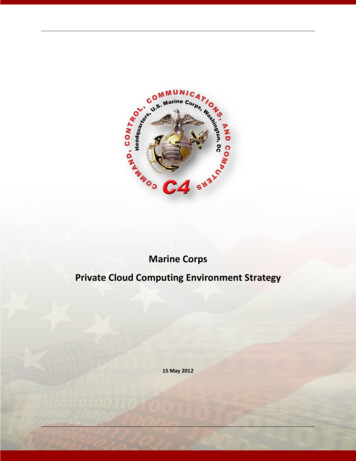
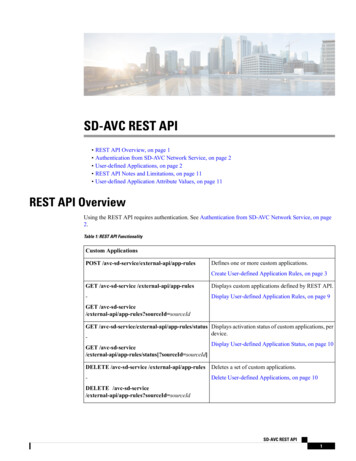
![[1]Oracle Enterprise Manager Cloud Control Basic Installation Guide .](/img/34/e22624.jpg)
